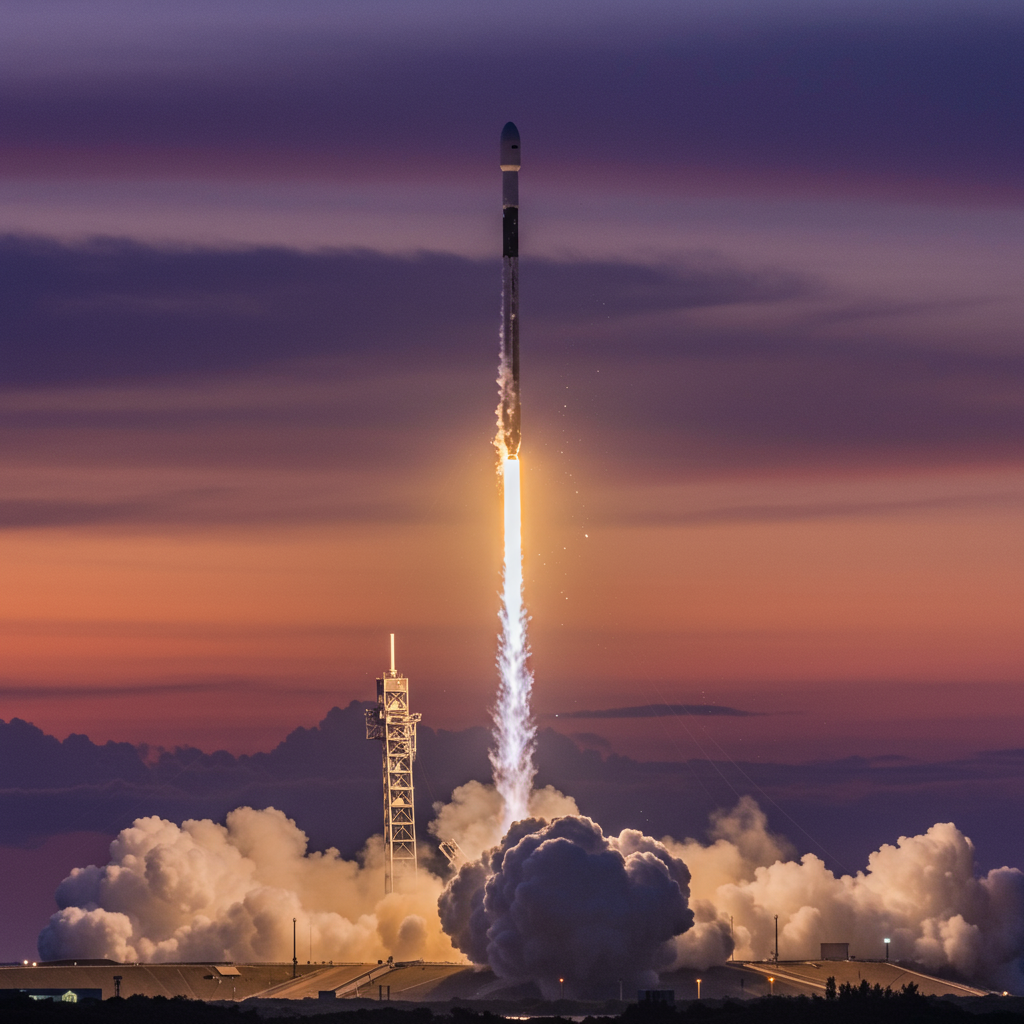A crucial new eye in the sky for European meteorology and air quality monitoring successfully launched into orbit aboard a SpaceX Falcon 9 rocket. Lifting off from Florida’s historic launch Complex 39A at NASA’s Kennedy Space Center on July 1, 2025, at 5:04 p.m. EDT (2104 GMT), the mission carried the Meteosat Third Generation Sounder satellite, designated MTG-S1. This advanced spacecraft represents a significant step forward in forecasting severe weather and tracking atmospheric pollution across Europe and Northern Africa. Operated by the European Organisation for the Exploitation of Meteorological Satellites (EUMETSAT) and developed in partnership with the European Space Agency (ESA) and the European Commission, the MTG-S1 is poised to deliver unprecedented data from its high perch in geostationary orbit.
A Critical Mission for Europe’s Future
The MTG-S1 satellite plays a dual role in enhancing environmental observation. Its primary instrument is a sophisticated infrared sounder designed to probe Earth’s atmosphere vertically. This capability allows meteorologists to build detailed 3D profiles of atmospheric temperature, humidity, wind, and trace gases. By capturing this data frequently – as often as every 15 minutes over target areas – MTG-S1 provides a dynamic picture of atmospheric conditions. This constant flow of information is essential for identifying the precursors to severe weather events, such as developing thunderstorms, enabling earlier warnings and more accurate forecasts.
The satellite also hosts a vital payload for the European Union’s Copernicus program: the Sentinel-4 instrument. This ultraviolet, visible, near-infrared light (UVN) spectrometer focuses specifically on air quality. It measures reflected light from Earth and direct sunlight to detect the presence and concentration of trace gases and pollutants, including nitrogen dioxide, ozone, sulfur dioxide, and formaldehyde. Operating from geostationary orbit, Sentinel-4 can provide hourly updates on air quality across its coverage area. This high-resolution pollution data is invaluable for monitoring environmental changes and supporting public health decisions.
Launch Details and Reusability Success
SpaceX executed the launch flawlessly using the Falcon 9 rocket. The mission originated from one of the most iconic launch pads globally, Pad 39A, previously used for Apollo and Space Shuttle missions. The specific Falcon 9 first stage booster supporting this flight, known as B1085, demonstrated SpaceX’s continued commitment to rocket reusability. This marked the ninth successful launch and landing for the booster. Its previous missions included significant flights like NASA’s Crew-9, a private astronaut mission called Fram2, and a mission earlier in 2025 carrying two private lunar landers for Firefly Aerospace and ispace.
Approximately 8.5 minutes after liftoff, the booster performed a precision landing on the autonomous drone ship “Just Read the Instructions,” positioned out in the Atlantic Ocean. This landing added to the vessel’s impressive track record and underscored the reliability of SpaceX’s reusable technology. The successful recovery of the booster helps reduce launch costs, a key element of SpaceX’s operational strategy. The upper stage of the Falcon 9 continued its ascent, successfully deploying the MTG-S1 satellite into a geostationary transfer orbit about 35 minutes after leaving the pad.
The Meteosat Third Generation Constellation
MTG-S1 is not a standalone satellite but a key component of the larger Meteosat Third Generation program. This ambitious program aims to create a constellation of six advanced satellites to replace the current Meteosat Second Generation system. The full constellation will consist of two sets of three satellites, with each set comprising one sounder satellite like MTG-S1 and two imager satellites. The first satellite in the series, MTG-Imager (MTG-I1), launched in December 2022. The second imager, MTG-I2, is planned for launch in 2026.
The MTG constellation is being built by prime contractors Thales Alenia Space and OHB System AG. While contracted in 2012, the program faced delays, partly due to the significant technological challenges involved in developing the hyperspectral sounding instrument carried by MTG-S1 and previous issues with European launch vehicle availability. The successful launch of MTG-S1 represents a major milestone in overcoming these challenges and bringing the full constellation closer to operation. Once fully deployed, the MTG system is projected to provide over 50 times the volume of weather data compared to the previous generation, dramatically improving meteorological capabilities for EUMETSAT’s 30 member states.
Advanced Technology for Detailed Observation
The technology packed into the roughly 3.8-tonne MTG-S1 satellite is cutting-edge. The IRS infrared sounder instrument weighs about 400 kg alone. It is Europe’s first hyperspectral sounding instrument operating from geostationary orbit. Hyperspectral capability means it can collect data across hundreds of narrow spectral bands, providing much richer information about the composition and vertical structure of the atmosphere than previous instruments. This high-resolution data (4×4 km spatial resolution) is vital for pinpointing conditions that lead to severe weather.
The satellite’s structure incorporates sophisticated engineering solutions to ensure the stability required for its sensitive instruments. Significant use of carbon fiber helps maintain structural integrity, while special rubber materials are employed for damping micro-vibrations that could affect instrument pointing accuracy. The Sentinel-4 UVN spectrometer also represents a significant engineering achievement, capable of detecting atmospheric trace gases at parts per billion levels from its distant orbit. This intricate setup allows near real-time detection of pollution patterns, offering crucial data for environmental policy and public health warnings.
Partnership and Commissioning Ahead
The MTG-S1 mission highlights a new model of cooperation between European entities. While EUMETSAT and ESA are the traditional partners for Meteosat satellites, the inclusion of the European Commission’s Sentinel-4 payload establishes a unique collaboration. Under this arrangement, EUMETSAT will handle the operational control of the satellite and the dissemination of data, including the air quality data from Sentinel-4, for the European Commission. This partnership leverages EUMETSAT’s expertise in satellite operations and data distribution for Earth observation programs beyond traditional meteorology.
Following its successful insertion into geostationary transfer orbit, the MTG-S1 satellite will undergo a crucial transfer period to reach its final geostationary operational slot, approximately 36,000 kilometers (22,369 miles) above the equator. Geostationary orbit allows the satellite to appear fixed over a specific geographic region, providing continuous monitoring. Once in position, the satellite will enter a roughly 9-12 month commissioning phase. During this time, engineers will meticulously turn on, calibrate, and validate the performance of both the IRS and Sentinel-4 instruments in the space environment. Only after this extensive checkout period will the satellite begin releasing validated, usable data to meteorologists and environmental scientists. Each MTG satellite carries enough fuel for over 10.7 years of operation, with a nominal life of 8.5 years.
Frequently Asked Questions
What is the MTG-S1 satellite used for?
The MTG-S1 satellite serves a critical dual purpose for Europe and Northern Africa. Its primary mission involves advanced weather monitoring using an infrared sounder instrument. This instrument collects detailed data on atmospheric temperature, humidity, and wind profiles, allowing meteorologists to create 3D maps of the atmosphere and significantly improve severe weather forecasting accuracy. Additionally, the satellite carries the Copernicus Sentinel-4 instrument, which monitors air quality by measuring atmospheric trace gases and pollutants like ozone and nitrogen dioxide hourly, aiding environmental analysis and public health protection.
Where was the MTG-S1 satellite launched from and where will it operate?
SpaceX launched the MTG-S1 satellite aboard a Falcon 9 rocket from Launch Complex 39A at NASA’s Kennedy Space Center in Florida. This location is part of the Space Coast, a key hub for orbital launches. Following launch, the satellite was placed into a geostationary transfer orbit and is now moving towards its final destination in geostationary Earth orbit (GEO). Located approximately 36,000 kilometers (22,369 miles) above the equator, GEO allows the satellite to remain positioned over a specific region (Europe/North Africa), providing continuous monitoring capabilities essential for weather and air quality observation.
How will MTG-S1 improve weather forecasting and air quality monitoring?
MTG-S1 brings significant improvements through its advanced instruments and operational orbit. The hyperspectral infrared sounder provides high-resolution 3D atmospheric data every 15 minutes, dramatically enhancing the ability to detect and track the rapid development of severe weather systems like convective storms. Combined with data from other MTG satellites, this allows for much more precise short-term forecasts and warnings. The Sentinel-4 instrument provides hourly, high-resolution maps of air pollution from geostationary orbit, a first for Europe, enabling better tracking of pollutant transport and supporting timely public health advisories and environmental management decisions based on near real-time data.
Looking Ahead
The successful launch of MTG-S1 represents a monumental achievement for European space programs and a significant step forward for Earth observation capabilities. As the satellite undergoes commissioning over the coming months, anticipation builds for the wealth of data it will provide. This mission, a testament to international collaboration and technological innovation, promises to enhance the safety and well-being of millions by improving our understanding and prediction of both weather phenomena and atmospheric pollution. The MTG constellation, once fully operational, will transform Europe’s ability to monitor its environment from space, providing essential data for meteorology, climate research, and environmental policy for decades to come.




